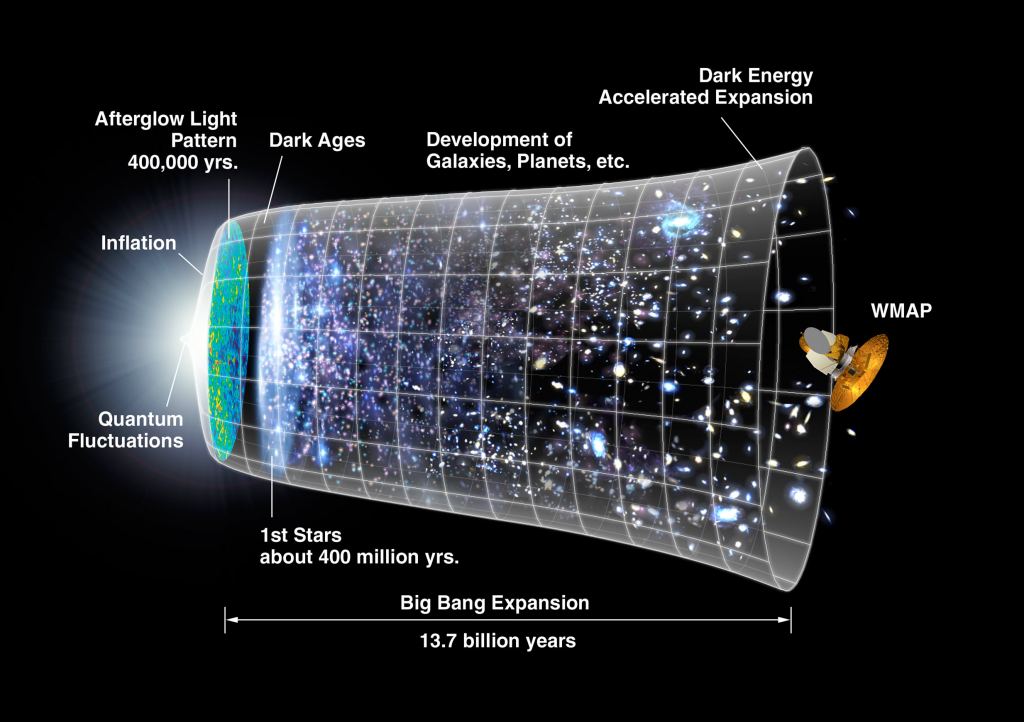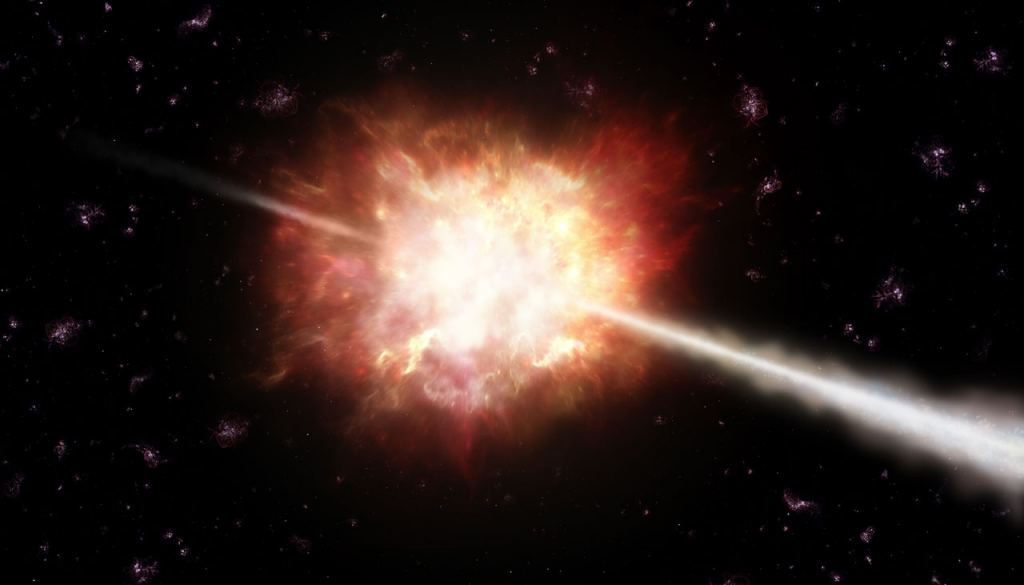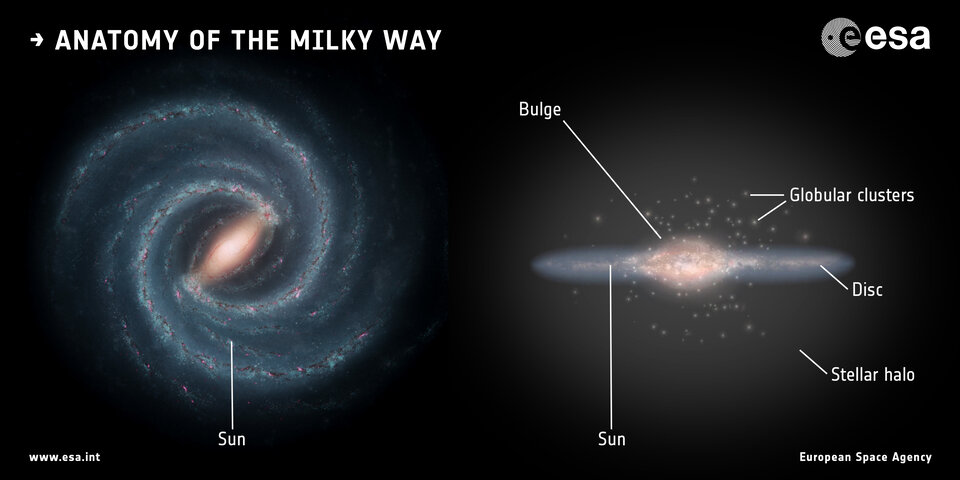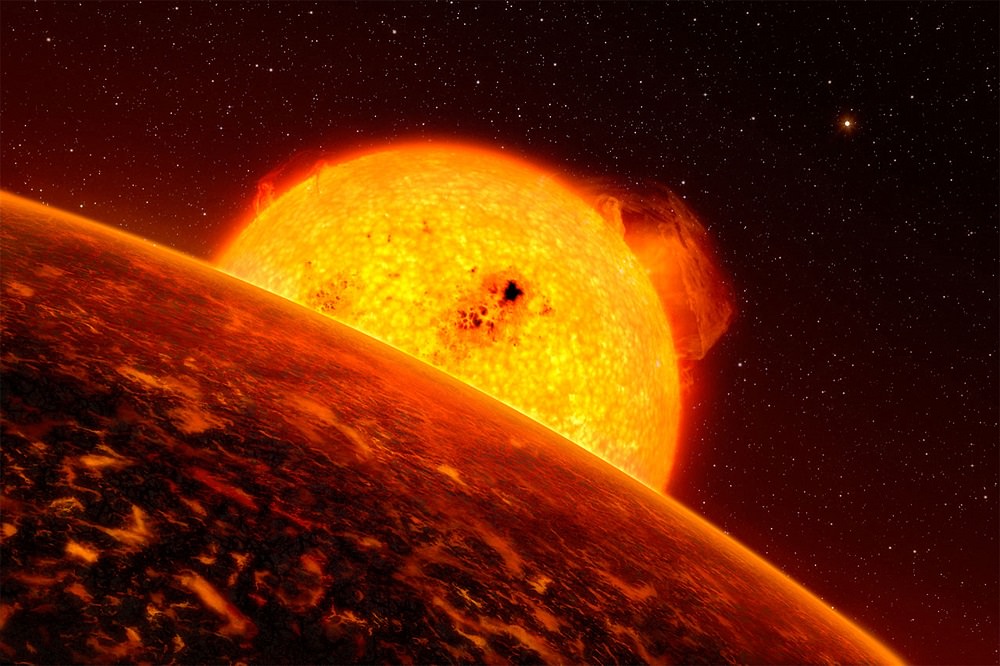Welcome back to our Fermi Paradox series, where we take a look at possible resolutions to Enrico Fermi’s famous question, “Where Is Everybody?” Today, we examine the possibility that the reason for the Great Silence is that we are “early to the party”!
In 1950, Italian-American physicist Enrico Fermi sat down to lunch with some of his colleagues at the Los Alamos National Laboratory, where he had worked five years prior as part of the Manhattan Project. According to various accounts, the conversation turned to aliens and the recent spate of UFOs. Into this, Fermi issued a statement that would go down in the annals of history: “Where is everybody?“
This became the basis of the Fermi Paradox, which refers to the disparity between high probability estimates for the existence of extraterrestrial intelligence (ETI) and the apparent lack of evidence. Since Fermi’s time, there have been several proposed resolutions to his question, which includes the Firstborn Hypothesis that states that humanity could be the first intelligent life to emerge in our galaxy.
The Firstborn Hypothesis is similar in some respects to the Hart-Tipler Conjecture and other schools of thought that attribute the “Great Silence” to the fact that humanity is the only advanced species in the known Universe. However, rather than assuming that intelligent life (or life in general) is non-existent, the Firstborn Hypothesis emphasizes that complex life (in all of its forms) has been rare until recently.

A Long Time Running
One of the main assumptions behind the Fermi Paradox is that life has had innumerable chances to emerge in our Universe. On the one hand, there is the abundance of space in our galaxy alone, which measures about 200,000 light-years in diameter, contains anywhere from 100 to 400 billion stars, and has an estimated 60 billion planets orbiting within their star’s habitable zone (HZ), 6 billion of which are “Earth-like.”
But then there’s the other all-important dimension, which is time. The Universe has been an estimated 13.8 billion years, the first galaxies existed by 13 billion years ago, and planets began to form shortly thereafter. Considering that our Solar System has only been around for the past 4.6 billion years or so, one would think that life in the Universe has a pretty big head start on Earth-based life forms.
But what if it didn’t? What if we are currently living in a cosmological window where the emergence of life is possible, and in previous epochs, conditions were too harsh for life to exist? Arguments of this nature have been made by many researchers attempting to resolve the Fermi Paradox. In each case, they began with the hypothesis that extraterrestrial life hasn’t had enough time to catch up with us, let alone overtake us.
Anthropic Principle
A key concept that informs this hypothesis is the Anthropic Principle, which is essentially the opposite of the Cosmological Principle (aka. Copernican Principle or “principle of mediocrity”). Whereas the latter assumes that life is typical within the cosmos, which means humanity is not in a unique and special position, the Anthropic Principle states that observations made of the Universe are entirely dependent on its laws being conducive to life.
The phrase itself was coined by theoretical astrophysicist Brandon Carter, who presented the idea during a 1973 symposium in Krakow, Poland, in honor of Copernicus’s 500th birthday. Here, he articulated the principle in response to the Copernican Principle, saying, “Although our situation is not necessarily central, it is inevitably privileged to some extent.”
Specifically, Carter challenged the way the Copernican Principle was being used to justify the idea that all large regions in the Universe (in both space and time) were statistically identical. This notion was central to the Steady State Hypothesis, which had recently been debunked with the discovery of the Cosmic Microwave Background (CMB) radiation. As David Brin would later describe it in the context of the Fermi debate:
“The philosophical counter to the principle of mediocrity is the ‘Anthropic Principle,’ which proposes that it is possible, even in a great and diverse Universe, for an observer to witness a special place and time, especially if the special attribute is required for there to be an observer in the first place… Uniqueness advocates see nothing wrong with the proposal that the intelligent life we see on Earth is rare.”
This principle is central to arguments that assert that humanity is alone in the Universe (or is the first intelligent species to arise in the Milky Way). Basically, it assumes that the Universe exists in a state of disequilibrium, where things have gone from being hostile to conducive to life. Humanity is therefore alive during a transitional phase in the Universe that will be followed by the emergence of many intelligent species.
Origin
While it is difficult to pinpoint the exact source of the Firstborn Hypothesis, many studies have been conducted throughout the years that have hinted at this premise. A solid example is the 1982 study by Lawrence Bracewell – a Professor with the Space, Telecommunications, and Radioscience Laboratory (STAR Lab) at Stanford University – titled “Preemption of the Galaxy by the first advanced civilization.”
In it, Bracewell considered how the first civilizations to emerge in an environment can invariably hold back those that follow. This theory was applied in support of his argument that humanity may be the first advanced civilization to emerge in our galaxy, hence why we haven’t heard from any others. As he summarized:
“[T]errestrial history demonstrates that the advent of one tool-capable and traveling population results in that species’ expansion to all viable territories. The spread of the population occurs in much shorter time than does the evolution of the species, indicating that, perhaps, humans are the first intelligent species in the Galaxy, and may be the future population of the Galaxy.”
If this is true, humanity may want to examine its “planetary protection” protocols and update them. In this case, rather than avoiding areas thought to have microbial life or sterilizing robotic missions to prevent contamination, perhaps we should take a page from the “Zoo Hypothesis” and create quarantine zones around inhabited planets to ensure we don’t interfere with the development of life on them.
Those Deadly GRBs!
James Annis of the Fermi National Accelerator Lab argued something similar in a 1999 study titled “An Astrophysical Explanation for the Great Silence.” According to Annis, periodic gamma-ray bursts (GRBs) could be responsible for limiting the emergence of intelligent life, since they occur at periodic intervals and are powerful enough to cause mass extinctions.
These bursts are the most energetic phenomena in the Universe and occur when massive stars go supernova. The bursts are usually brief (but can be long-lived in the event of a binary companion), emerge from the star’s axis of rotation (aka. polar regions), and be lethal to any planets that lie along their path. In fact, recent research indicates that a GRB may have been responsible for the Ordovician Extinction (ca. 440 million years ago).
Annis employed then-current astrophysical models that suggest that the mean time between GRBs is on the order of 1 billion years. Similarly, evolutionary models used by Annis indicate that this is the same amount of time it takes for intelligence to emerge. This is consistent with the interval between the existence of multi-cellular life and high-order primates (which includes modern humans). As he summarized:
“If one assumes that [GRBs] are in fact lethal to land based life throughout the galaxy, one has a mechanism that prevents the rise of intelligence until the mean time between bursts is comparable to the timescale for the evolution of intelligence…
“Hence, this model suggests that the Galaxy is currently undergoing a phase transition between an equilibrium state devoid of intelligent life to a different equilibrium state where it is full of intelligent life.”

In 2008, astronomers Milan M. Cirkovic and Branislav Vukotic of the Astronomical Observatory of Belgrade build upon this argument with a study titled “Astrobiological Phase Transition: Towards Resolution of Fermi’s Paradox.” For their study, Cirkovic and Branislav created a model to test whether or not gamma-ray bursts and other astrobiological regulating mechanisms can periodically “reset” the cosmological clock.
However, these events occur with exponentially decreasing frequency over time, creating longer and longer windows in which biogenesis (the emergence of life) and noogenesis (the emergence of intelligence) can occur. Overall, their argument employs both the Anthropic Principle and the idea that the Universe is in a phase of disequilibrium. As they stated:
“Secular evolution of regulation mechanisms leads to the brief epoch of phase transition: from an essentially dead place, with pockets of low-complexity life restricted to planetary surfaces, it will, on a short (Fermi–Hart) timescale, become filled with high-complexity life. An observation selection effect explains why we are not, in spite of the very small prior probability, to be surprised at being located in that brief phase of disequilibrium.”
Early to the Party?
A similar argument was made by Prof. Abraham Loeb of the Harvard Smithsonian Center for Astrophysics (CfA) and postdoctoral researchers Rafael A. Batiste and David Sloan (of the University of Oxford). In this study, titled “Relative Likelihood for Life as a Function of Cosmic Time,” Loeb and his colleagues calculated the probability of habitable Earth-like planets forming within a certain volume of space over time.
Beginning with the first stars, which formed roughly 30 million years after the Big Bang, and continuing into the distant future, they found that the emergence of life (as we know it) is directly dependent on the mass of the star involved and increases in probability over longer stretches of time. Essentially, high-mass stars have a shorter life-span, which means they likely die before life can emerge on any planets orbiting them.
Lower mass stars like M-type red dwarfs have much longer lifespans and can remain in their main sequence phase for up to twelve trillion years. Ultimately, Loeb and his colleagues confirmed that planets orbiting red dwarf stars (barring factors that would suppress their potential habitability) are much more likely to support life over longer timescales. Or as Leob said in a CfA press statement issued coincidentally with the study:
“If you ask, ‘When is life most likely to emerge?’ you might naively say, ‘Now’. But we find that the chance of life grows much higher in the distant future. So then you may ask, why aren’t we living in the future next to a low-mass star? One possibility is we’re premature. Another possibility is that the environment around a low-mass star is hazardous to life.”
Criticisms
If we follow this logic, then the reason there is such a thing as the “Great Silence” is that until recently, the Universe was not particularly conducive to intelligent life. While simple life may be plentiful, the timescales between gamma-ray bursts or other astrobiological regulating mechanisms have been too short to allow for intelligent life to emerge. From an evolutionary and cosmological standpoint, this certainly makes sense.

Naturally, critics of this hypothesis would cite that it is not only Anthropic in its outlook but anthropocentric. While it seems presumptuous to assume that the evolution of life in our galaxy (or the Universe) would follow a similar trajectory as humanity’s, it is similar to assume that humanity would be the only intelligent species to develop communication technologies that could be detected from space.
Another issue arising from this hypothesis is the fact that it is very difficult to test. While remote sensing techniques would be capable of confirming the presence of life through the detection of biosignatures, they would not be able to determine whether that life is intelligent or not. This is what is often referred to as the “algae vs. alumnae” problem.
And of course, there’s the assumption that GRBs are becoming less common with time. At present, there is no definitive evidence that these bursts have become less common since Earth formed roughly 4.5 billion years ago. In fact, some estimates claim that as many as 1,000 GRBs have taken place close enough to Earth to affect life since it began 4 billion years ago.
Even if every single extinction event in Earth’s history could be linked to GRBs, it clearly didn’t prevent the emergence of intelligent life. In the end, the Firstborn Hypothesis is not unlike most theories that fall into the Great Filter, with the filter being applied either somewhere in the middle or many times over the course of a planet’s history.

In the end, a key assumption of the Fermi Paradox is that ETIs should have expanded beyond their star system and left undeniable traces of their existence by now. The fact that we can’t find any is seen as an indication that they must not exist. But what if this is a simple case of preemption, where humanity is the first (or one of the first) to emerge in our galaxy?
Rather than deterring us from investigating further, this theory invites us to keep looking – if for no other reason, than to confirm that we are the only current technologically-advanced species. If humanity is “early to the party,” it gives us a chance to do the kinds of things that we’ve long-speculated more advanced species would do.
We could play God, tamper with evolution, uplift species that are on the verge of sentience, or inhibit their development. Or, as a radical alternative, we could act responsibly for a change! If humanity’s place in the Universe is somehow special and privileged, then we should behave the way we would want a more advanced species to behave towards us.
We have written many interesting articles about the Fermi Paradox, the Drake Equation, and the Search for Extraterrestrial Intelligence (SETI) here at Universe Today.
Here’s Where Are The Aliens? How The ‘Great Filter’ Could Affect Tech Advances In Space, Why Finding Alien Life Would Be Bad. The Great Filter, How Could We Find Aliens? The Search for Extraterrestrial Intelligence (SETI), and Fraser and John Michael Godier Debate the Fermi Paradox.
And be sure to check out the rest of our Beyond Fermi’s Paradox series:
- Beyond “Fermi’s Paradox” I: A Lunchtime Conversation- Enrico Fermi and Extraterrestrial Intelligence
- Beyond “Fermi’s Paradox” II: Questioning the Hart-Tipler Conjecture
- Beyond “Fermi’s Paradox” III: What is the Great Filter?
- Beyond “Fermi’s Paradox” IV: What is the Rare Earth Hypothesis?
- Beyond “Fermi’s Paradox” V: What is the Aestivation Hypothesis?
- Beyond “Fermi’s Paradox” VI: What is the Berserker Hypothesis?
- Beyond “Fermi’s Paradox” VII: What is the Planetarium Hypothesis?
- Beyond “Fermi’s Paradox” VIII: What is the Zoo Hypothesis?
- Beyond “Fermi’s Paradox” IX: What is the Brief Window Hypothesis?
- Beyond “Fermi’s Paradox” IX: What is the Brief Window Hypothesis?
- Beyond “Fermi’s Paradox” XI: What is the Transcension Hypothesis?
- Beyond “Fermi’s Paradox” XII: What is the Water Worlds Hypothesis?
- Beyond “Fermi’s Paradox” XIII: What is the “Ocean Worlds” Hypothesis?
- Beyond “Fermi’s Paradox” XIV: What is the Aurora Hypothesis?
- Beyond “Fermi’s Paradox” XV: What is the Percolation Theory Hypothesis?
- Beyond “Fermi’s Paradox” XVI: What is the “Dark Forest” Hypothesis?
- Beyond “Fermi’s Paradox” XVII: What is the “SETI-Paradox” Hypothesis?
Astronomy Cast has some interesting episodes on the subject. Here’s Episode 24: The Fermi Paradox: Where Are All the Aliens?, Episode 110: The Search for Extraterrestrial Intelligence, Episode 168: Enrico Fermi, Episode 273: Solutions to the Fermi Paradox.
Sources:
- “The Anthropic Principle and the Structure of the Physical World.” Nature Vol. 278 (1979)
- Bracewell, R. “Preemption of the Galaxy by the First Advanced Civilization.” in Extraterrestrial – Where are They? Pergmon Press, Oxford (1982)
- Brin, G.D. “The Great Silence – the Controversy Concerning Extraterrestrial Intelligent Life.” Quarterly Journal of the Royal Astronomical Society, Vol. 24 (1983)
- Annis, J. “An Astrophysical Explanation for the Great Silence.” Journal of the British Interplanetary Society. Vol. 52 (1999)
- Cirkovic, M.M. & Branislav, V. “Astrobiological Phase Transition: Towards Resolution of Fermi’s Paradox.” Origins of Life and Evolution of Biospheres, Vol. 38 (2008)
- Melott, A. L. (et al.) “Did a gamma-ray burst initiate the late Ordovician mass extinction?” International Journal of Astrobiology, Vol. 3, No. 55 (2004)
- Hair, T. W. “Temporal Dispersion of the Emergence of Intelligence: an Inter-Arrival Time Analysis.” International Journal of Astrobiology, Vol. 10 , No. 2 (2011)
- Loeb, A. (et al.) “Relative Likelihood for Life as a Function of Cosmic Time.” Journal of Cosmology and Astroparticle Physics, Vol. 8 (2016)


I find the idea of humanity acting responsibly if we discovered alien life rather amusing. Since this is a science based website, I have to ask the question, “Where’s your evidence ?”